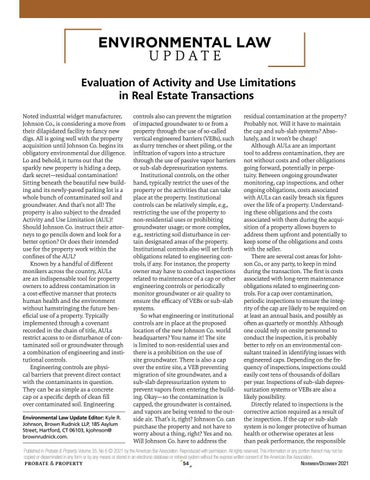ENVIRONMENTAL LAW U P D AT E Evaluation of Activity and Use Limitations in Real Estate Transactions Noted industrial widget manufacturer, Johnson Co., is considering a move from their dilapidated facility to fancy new digs. All is going well with the property acquisition until Johnson Co. begins its obligatory environmental due diligence. Lo and behold, it turns out that the sparkly new property is hiding a deep, dark secret—residual contamination! Sitting beneath the beautiful new building and its newly-paved parking lot is a whole bunch of contaminated soil and groundwater. And that’s not all! The property is also subject to the dreaded Activity and Use Limitation (AUL)! Should Johnson Co. instruct their attorneys to go pencils down and look for a better option? Or does their intended use for the property work within the confines of the AUL? Known by a handful of different monikers across the country, AULs are an indispensable tool for property owners to address contamination in a cost-effective manner that protects human health and the environment without hamstringing the future beneficial use of a property. Typically implemented through a covenant recorded in the chain of title, AULs restrict access to or disturbance of contaminated soil or groundwater through a combination of engineering and institutional controls. Engineering controls are physical barriers that prevent direct contact with the contaminants in question. They can be as simple as a concrete cap or a specific depth of clean fill over contaminated soil. Engineering Environmental Law Update Editor: Kyle R. Johnson, Brown Rudnick LLP, 185 Asylum Street, Hartford, CT 06103, kjohnson@ brownrudnick.com.
controls also can prevent the migration of impacted groundwater to or from a property through the use of so-called vertical engineered barriers (VEBs), such as slurry trenches or sheet piling, or the infiltration of vapors into a structure through the use of passive vapor barriers or sub-slab depressurization systems. Institutional controls, on the other hand, typically restrict the uses of the property or the activities that can take place at the property. Institutional controls can be relatively simple, e.g., restricting the use of the property to non-residential uses or prohibiting groundwater usage; or more complex, e.g., restricting soil disturbance in certain designated areas of the property. Institutional controls also will set forth obligations related to engineering controls, if any. For instance, the property owner may have to conduct inspections related to maintenance of a cap or other engineering controls or periodically monitor groundwater or air quality to ensure the efficacy of VEBs or sub-slab systems. So what engineering or institutional controls are in place at the proposed location of the new Johnson Co. world headquarters? You name it! The site is limited to non-residential uses and there is a prohibition on the use of site groundwater. There is also a cap over the entire site, a VEB preventing migration of site groundwater, and a sub-slab depressurization system to prevent vapors from entering the building. Okay—so the contamination is capped, the groundwater is contained, and vapors are being vented to the outside air. That’s it, right? Johnson Co. can purchase the property and not have to worry about a thing, right? Yes and no. Will Johnson Co. have to address the
residual contamination at the property? Probably not. Will it have to maintain the cap and sub-slab systems? Absolutely, and it won’t be cheap! Although AULs are an important tool to address contamination, they are not without costs and other obligations going forward, potentially in perpetuity. Between ongoing groundwater monitoring, cap inspections, and other ongoing obligations, costs associated with AULs can easily breach six figures over the life of a property. Understanding these obligations and the costs associated with them during the acquisition of a property allows buyers to address them upfront and potentially to keep some of the obligations and costs with the seller. There are several cost areas for Johnson Co., or any party, to keep in mind during the transaction. The first is costs associated with long-term maintenance obligations related to engineering controls. For a cap over contamination, periodic inspections to ensure the integrity of the cap are likely to be required on at least an annual basis, and possibly as often as quarterly or monthly. Although one could rely on onsite personnel to conduct the inspection, it is probably better to rely on an environmental consultant trained in identifying issues with engineered caps. Depending on the frequency of inspections, inspections could easily cost tens of thousands of dollars per year. Inspections of sub-slab depressurization systems or VEBs are also a likely possibility. Directly related to inspections is the corrective action required as a result of the inspection. If the cap or sub-slab system is no longer protective of human health or otherwise operates at less than peak performance, the responsible
Published in Probate & Property, Volume 35, No 6 © 2021 by the American Bar Association. Reproduced with permission. All rights reserved. This information or any portion thereof may not be copied or disseminated in any form or by any means or stored in an electronic database or retrieval system without the express written consent of the American Bar Association.
54
November/December 2021










